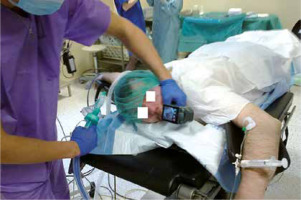Dear Editor,
We read with great interest the case report of Pagano et al. [1] on use of the KingVision videolaryngoscope (VL) in prone position. This case is further proof of the usefulness of VLs in specific condition intubations. There are several papers confirming that VLs can be used for intubation in prone position. We would like to discuss a life-threating situation during general anesthesia such as sudden unexpected extubation in a patient positioned in prone position for example for spine surgery. In this case usually surgical area was covered and the patient has to be positioned in supine position for reintubation.
Several published papers suggest that in this case other action can be performed: use of supraglottic devices (SAD) is well described [2] and use of VLs is also considered as a safe and effective approach [3]. Our clinical experience confirms that thesis. We performed several elective airway management procedures in patients positioned in prone position using SAD and VLs with great success (Figures 1 and 2) with no complications and mean time to achieve ventilation was below 15 s. We used second gene-ration SAD as they are considered to be more effective due to the second seal, preformed shape and possibility of fiberoptic intubation through SAD’s lumen properties. These are for example Ambu Aura Gain, Air-Q or iLTS-D. LMA Supreme can be used as it has a second seal but in case of need for intubation the Aintree intubation catheter has to used, which complicates the procedure. As for VLs it seems that use of channeled VLs is better in those circumstances (for example AirTraq or KingVision) [1, 3, 4]. However, the provider must be an expert in VL intubation to attempt it in the patient’s prone position.
Although there are enough papers to support the usefulness of SADs in prone positioned patients for elective procedures, still there is need for randomized trials on the effectiveness of SADs or VLs in patients with prone position as rescue devices [5]. In the review of Abrishami et al. over half a thousand patients were successfully managed with SADs in adult patients in prone position with a success rate of first pass 87% and second attempt 100% [5].
We assume that there are enough case reports and manikin studies confirming that SADs or VLs can be used as rescue devices for unexpected extubation in patients positioned in prone position [3, 4, 6–9]. Therefore, we would like to propose following algorithm of management of sudden unexpected extubation in patients positioned in prone position. The question to be solved is the use of apneic oxygenation via for example high flow nasal oxygenation or nasal CPAP to prolong the safe apnea period during intubation efforts using VLs in patients positioned in prone position. However, there are several papers confirming that apneic oxygenation can be used successfully to maintain oxygenation during prolonged intubation efforts [10, 11].
The algorithm is based on the difficult airway management algorithm. The first step is to call for help and prepare to change the position of the patient to supine. In the meantime the equipment for a difficult airway should be prepared for use: a supraglottic device and fiberoscope or VL. The use of supraglottic devices is the second step in the algorithm – the main aim is to restore proper oxygenation of the patient. If adequate ventilation was achieved continuing anesthesia with airway secured with SAD may be considered or fiberoptic intubation through the SAD lumen or intubation using VLs. The second generation of SADs should be used. If ventilation using SADs is not satisfactory (which is very rare [5]) the position of the patient should be changed to supine and intubation should be performed. Apneic oxygenation may be considered as an option to increase oxygenation of the patient while changing the patient’s position to supine for intubation efforts.
For attempts of intubation in prone position (after restoring adequate oxygenation of the patient) the channeled VLs should be considered as they make it possible to intubate faster in this specific patient’s position [3, 4]. If intubation is not successful using channeled VL in prone position then use of SAD could be considered; however, changing the patient’s position to supine is also an option. The attempts of intubation in prone position require experience in use of both VLs and fiberoscopes [12].
In conclusion, basing on a literature review and our experience, we assume that the proposed algorithm may be used for sudden unexpected extubation in patients positioned in prone position as it is similar to the main steps of the management of difficult airway algorithm and can increase safety of anesthetized patients. It is important to train techniques that are included in the algorithm, for example placement of supraglottic airway devices in different approach techniques like the front approach and the lateral approach [13].







